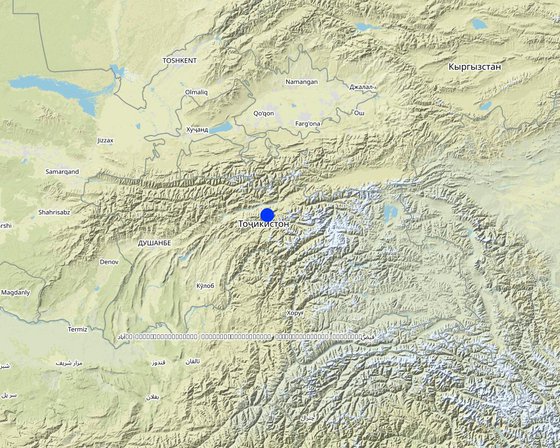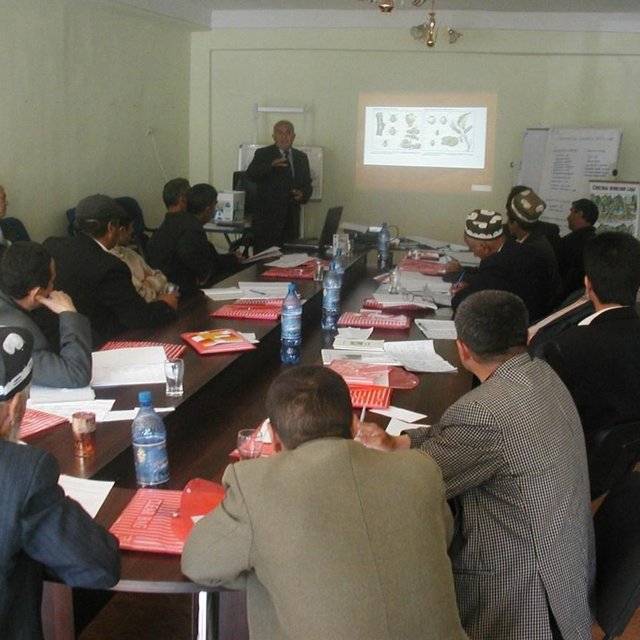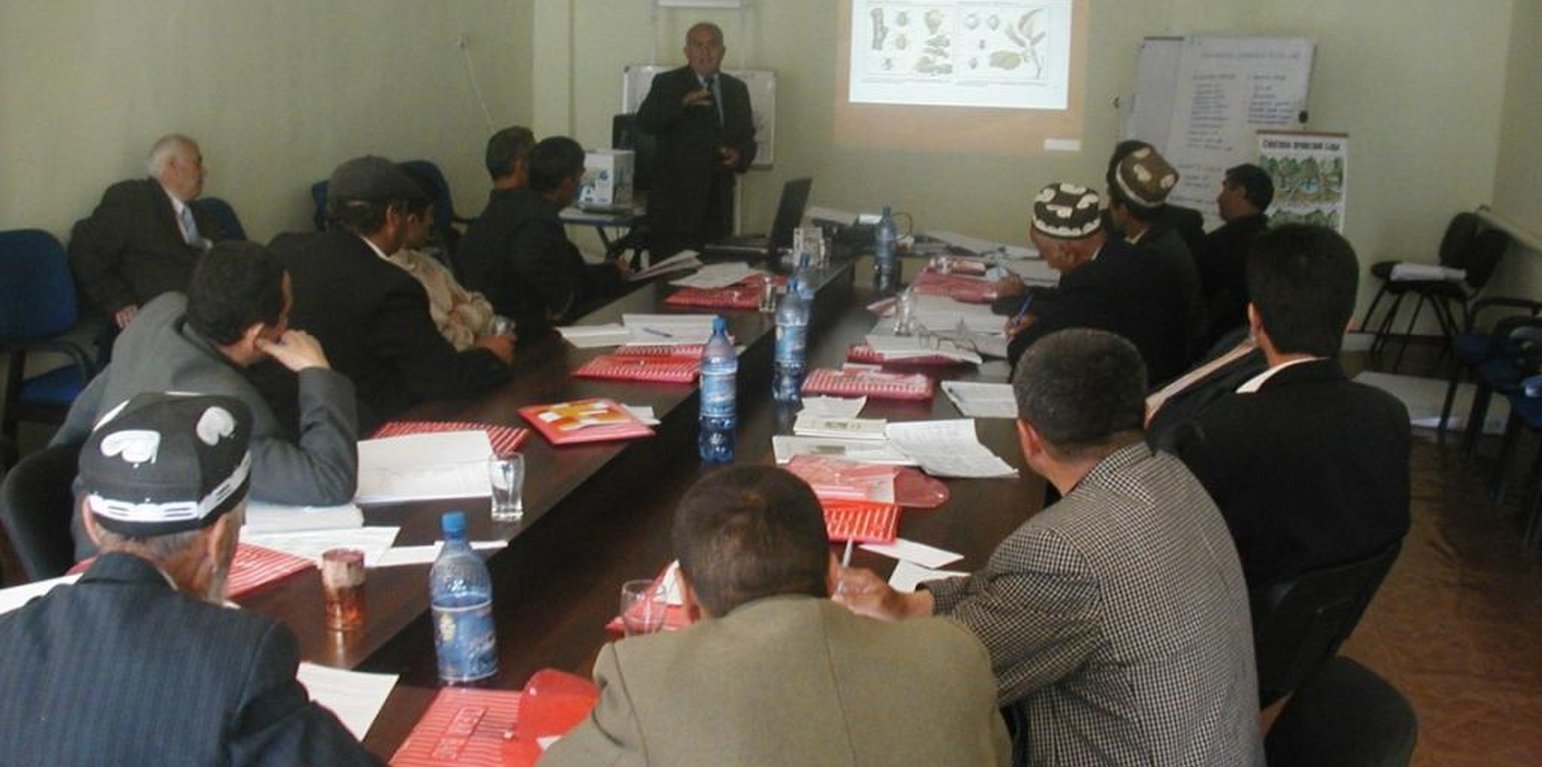Facilitation of community-based pasture management initiatives
(ប្រទេសតាហ្ស៊ីគីស្ថាន)
Mountain Societies Development Support Programme - Aga Khan Foundation
ការពណ៌នា
Initiation of community-based solutions to slow down pasture degradation, and to improve pasture use and management in three pilot Jamoats of upland Tajikistan.
Aims / objectives: During the Soviet times land users in Tajikistan were allowed to keep very little livestock individually and this was mainly in the vicinity of rural settlements. The majority of the livestock were managed by collective agricultural farms, which utilised different seasonal pastures. After the collapse of the Soviet Union, the previously state-owned livestock was distributed among individual farmers, most of whom had limited knowledge and experience with pasture management (PM), and capacities to access the distant pastures used by the collective farms. As a consequence, the amount of livestock kept in the vicinity of rural settlements increased, leading to overgrazing and severe degradation of nearby pastures. In the framework of a project on sustainable land management in the Pamir-Alai region (PALM), funded by the Global Environment Facility (GEF), MSDSP facilitated the initiation of community-based solutions to the problem of pasture degradation at three pilot jamoats in Jirgital, and three in Gorno-Badakhshan Autonomous Oblast (GBAO).
Methods: 1. Awareness raising and capacity building of PM issues. 2. Integration of PM issues in village development plans. 3. Grant support and community co-financing for implementation of targeted measures. 4. Monitoring of the impacts of the implemented measures as a basis for up-scaling.
Stages of implementation: 1. National pasture management experts from the Pamir Biological Institute held a training of trainers (ToT) session for MSDSP facilitators and district specialists, who conducted follow-up training on PM at the pilot communities in 2009. 2. Pilot communities identified key problems related to PM in the process of Village Development Planning facilitated by MSDSP, and prioritised targeted measures for improved PM. 3. A set of micro-project proposals were developed based on the prioritised measures, which focused on (re-) construction of roads and bridges for improved access to pastures, and construction of stables during spring/autumn, as well as summer pastures. 4. Monitoring of the impacts of the implemented measures as a basis for up-scaling.
Role of stakeholders: Community members were engaged in identifying and implementing targeted measures for addressing pasture use and management issues. Jamoat level non-governmental organisations called Social Unions for Development of Village Organizations (SUDVOs), coordinated and supported the identification and implementation of the selected projects in several village organisations. Governmental agricultural extension agents were engaged in training, and consulted in the review process. MSDSP staff facilitated the overall process and engaged in monitoring progress with implementation. PALM project staff engaged in the review, monitoring and assessment of the impacts of the supported measures.
ទីតាំង

ទីតាំង: Jirgatol, ប្រទេសតាហ្ស៊ីគីស្ថាន
ចំណុចយោងភូមិសាស្ត្រនៃទីតាំងជ្រើសរើស
កាលបរិច្ឆេទចាប់ផ្តើម: 2009
ឆ្នាំបញ្ចប់: មិនមាន
ប្រភេទនៃវិធីសាស្ត្រផ្សព្វផ្សាយ
-
ក្រុមប្រពៃណី/ក្រុមជនជាតិភាគតិច
-
អ្នកផ្តួចផ្តើមក្នុងតំបន់/អ្នករុករកឃើញថ្មីៗ
-
ផ្អែកលើគម្រោង/កម្មវិធី

Training of Trainers through expert (MSDSP Khorog)
គោលបំណងនៃវិធីសាស្រ្តផ្សព្វផ្សាយនិងបរិស្ថានអំណោយផល
គោលបំណងនៃវិធីសាស្រ្តផ្សព្វផ្សាយ
The Approach focused mainly on SLM with other activities (rehabilitation of rural infrastructure to improve access to pastures, pasture and livestock productivity, animal diseases)
The main aim of the approach was to initiate the improved use and management of pastures, by raising awareness and knowledge on issues regarding pasture degradation and sustainable pasture management, mobilising community action, and pilot-testing selected technologies and measures for improving pasture management in highly degraded areas.
The SLM Approach addressed the following problems: pasture degradation, overgrazing, restricted pasture area and too many cattle garzing, lack of infrastructure (bridges, roads, shelters), lack of knowledge about pasture management
លក្ខខណ្ឌអំណោយផលដល់ការអនុវត្តបចេ្ចកទេសដែលបានប្រើក្នុងវិធីសាស្រ្តផ្សព្វផ្សាយ
លក្ខខណ្ឌរាងរាំងដល់ការអនុវត្តបចេ្ចកទេសដែលបានប្រើក្នុងវិធីសាស្រ្តផ្សព្វផ្សាយ
-
ភាពអាចរកបាននៃធនធានហិរញ្ញវត្ថុ និងសេវាកម្ម: communities were lacking funds for infrastructure development and could therefore not invest in the construction of roads and bridges
Treatment through the SLM Approach: GEF funds were used to support communities in financing infrastructural improvements which allowed for more productive and sustainable use of available pasture resources
-
បរិបទនៃស្ថាប័ន: Lack of capacity to deal with pasture degradation problems
Treatment through the SLM Approach: Engagement of village organisations, and social unions of village organisations (SUDVO) in addressing pasture management issues at six pilot jamoats
-
ក្របខណ្ឌច្បាប់ (សិទ្ធិកាន់កាប់ដីធ្លី កម្មសិទ្ធីប្រើប្រាស់ដីនិងទឹក): Limited clarity regarding responsibilities and lack of incentives for sustainable pasture management
Treatment through the SLM Approach: MSDSP and PALM project members recommended the development of a pasture management law that addresses those legal constrains
The existing land ownership, land use rights / water rights moderately hindered the approach implementation there is no law about pasture management in Tajikistan, therefore it was difficult to regulate the process
-
ចំណេះដឹងស្តីពី SLM និងការទទួលបានការគាំទ្រផ្នែកបច្ចេកទេស: technical knowledge about pasture management was lacking as during Soviet times people were not allowed to keep a lot of livestock
Treatment through the SLM Approach: Community members of village organisations and relevant government experts were trained in various issues of pasture management
ការចូលរួមនិងតួរនាតីរបស់ភាគីពាក់ព័ន្ធដែលចូលរួម
ភាគីពាក់ព័ន្ធដែលចូលរួមក្នុងវិធីសាស្រ្តផ្សព្វផ្សាយ និងតួរនាទីរបស់គាត់
| តើមានភាគីពាក់ព័ន្ធ/ភ្នាក់ងារអនុវត្តន៍ណាខ្លះដែលបានចូលរួមក្នុងវិធីសាស្ត្រផ្សព្វផ្សាយ? |
សូមបញ្ជាក់ភាគីពាក់ព័ន្ធ |
សូមពណ៌នាតួនាទីរបស់ភាគីពាក់ព័ន្ធ |
| អ្នកប្រើប្រាស់ដីក្នុងតំបន់/សហគមន៍ |
Village organisations
Only 20% of the participants were women, since men are responsible for managing the livestock, while women are concerned with livestock products only
Elderly members of the communities were engaged in discussions on the possible solutions |
|
| អ្នកឯកទេសគ្រប់គ្រងដីប្រកបដោយចីរភាព/ទីប្រឹក្សាបច្ចេកទេសកសិកម្ម |
Governmental agricultural advisors participated in the training. |
|
| រដ្ឋាភិបាលថ្នាក់ជាតិ (អ្នករៀបចំផែនការ អ្នកសម្រេចចិត្ត) |
Agrarian University in Jirgatol, Pamir Biological Institute |
|
| pilot communities |
|
|
ការចូលរួមពីអ្នកប្រើប្រាស់ដីឬសហគមមូលដ្ឋានក្នុងតំណាក់កាលផ្សេងគ្នានៃវិធីសាស្រ្តផ្សព្វផ្សាយ
គ្មាន
អសកម្ម
ការគាំទ្រពីខាងក្រៅ
អន្តរកម្ម
គំនិតផ្តួចផ្តើមដោយខ្ឡួនឯង
ការចាប់ផ្តើម/ការលើកទឹកចិត្ត
ការរៀបចំផែនការ
Members of village organisations were involved in training and planning on pasture management, and actively participated in discussions
ការអនុវត្តន៍
The village organisations developed their own project ideas and submitted those proposals to MSDSP and other funders
ការត្រួតពិនិត្យ និងវាយតម្លៃ
Land users were engaged in the monitoring and evaluation of the impacts of the implemented projects
Research
The Pamir-Biological Institute and the Institute of Botany under the Academy of Sciences were engaged in research and technical consultations
ការសម្រេចចិត្តលើការជ្រើសរើសបច្ចេកទេស SLM
ការសម្រេចចិត្តត្រូវបានធ្វើដោយ
-
អ្នកប្រើប្រាស់ដីដោយខ្លួនឯងផ្ទាល់ (គំនិតផ្តួចផ្តើមដោយខ្លួនឯង)
-
អ្នកប្រើប្រាស់ដី ដោយមានការគាំទ្រពីអ្នកជំនាញឯកទេស SLM
-
គ្រប់ភាគីពាក់ព័ន្ធទាំងអស់ដែលជាផ្នែកនៃវិធីសាស្រ្តផ្សព្វផ្សាយដោយមានការចូលរួម
-
អ្នកជំនាញឯកទេស SLM បន្ទាប់ពីបានប្រឹក្សាយោបល់ជាមួយអ្នកប្រើប្រាស់ដី
-
អ្នកជំនាញឯកទេស SLM តែឯង
-
អ្នកនយោបាយ /អ្នកដឹកនាំ
-
pilot communities
ការសម្រេចចិត្តត្រូវបានធ្វើដោយផ្អែកលើ៖
-
វាយតម្លៃទៅលើចំណេះដឹងស្តីអំពី SLM ដែលបានចងក្រងជាឯកសារបានត្រឹមត្រូវ (ផ្អែកលើភស្តុតាងជាមូលដ្ឋានដើម្បីសម្រេចចិត្ត)
-
លទ្ធផលបានពីការស្រាវជ្រាវ
-
បទពិសោធន៍ និងគំនិតផ្ទាល់ខ្លួន(ពុំមានចងក្រងជាឯកសារ)
ការគាំទ្របច្ចេកទេស ការកសាងសមត្ថភាព និងការគ្រប់គ្រងចំណេះដឹង
សកម្មភាព ឬសេវាកម្មខាងក្រោមបានប្រើជាផ្នែកនៃវិធីសាស្ត្រផ្សព្វផ្សាយ
-
ការកសាងសមត្ថភាព/ បណ្តុះបណ្តាល
-
សេវាផ្តល់ប្រឹក្សាយោបល់
-
ការពង្រឹងសមត្ថភាពស្ថាប័ន (ការអភិរឌ្ឍន៍អង្គភាព)
-
ការត្រួតពិនិត្យ និងវាយតម្លៃ
-
ការស្រាវជ្រាវ
ការកសាងសមត្ថភាព/ ការបណ្តុះបណ្តាល
ការបណ្តុះបណ្តាលបានផ្តល់ដល់អ្នកពាក់ព័ន្ធដូចខាងក្រោម
-
អ្នកប្រើប្រាស់ដី
-
បុគ្គលិកចុះទីវាល/អ្នកផ្តល់ប្រឹក្សាយោបល់
ទម្រង់នៃការបណ្តុះបណ្តាល
-
អនុវត្តន៍ជាមួយការងារ
-
ពីកសិករទីកសិករ
-
ទីតាំងបង្ហាញ
-
ការប្រជុំជាសាធារណៈ
-
វគ្គបណ្តុះបណ្តាល
មុខវិទ្យាដែលបានបញ្ចូល
Short training courses were provided for land user, field staff/agricultural advisors
សេវាកម្មប្រឹក្សា
សេវាកម្មប្រឹក្សាត្រូវបានផ្តល់ឱ្យ
-
នៅលើដីរបស់អ្នកប្រើប្រាស់ដី
-
នៅមជ្ឈមណ្ឌលជាអចិន្ត្រៃ
-
through trained experts
Name of method used for advisory service: Engineering support and technical consultations
Advisory service is quite adequate to ensure the continuation of land conservation activities
ការពង្រឹងស្ថាប័ន
ស្ថាប័នត្រូវបានព្រឹង/ បង្កើត
-
ទេ
-
បាទ/ច៎ា តិចតួច
-
បាទ/ច៎ា ជាមធ្យម
-
បាទ/ច៎ា បានខ្លាំង
នៅកម្រិតដូចខាងក្រោម
-
ថ្នាក់មូលដ្ឋាន
-
កម្រិតថ្នាក់តំបន់
-
កម្រិតថ្នាក់ជាតិ
ពិពណនាស្ថាប័ន៖ តួនាទី និងការទទួលខុសត្រូវ សមាជិក ។ល។
ប្រភេទនៃការគាំទ្រ
-
ហិរញ្ញវត្ថុ
-
ការកសាងសមត្ថភាព/ បណ្តុះបណ្តាល
-
សម្ភារៈ
សេចក្តីលម្អិតបន្ថែមទៀត
village organisations were trained
ការត្រួតពិនិត្យ និងវាយតម្លៃ
economic / production aspects were regular monitored by project staff through observations; indicators: changes in economic benefits for households before and after implementation of project
bio-physical aspects were regular monitored by project staff through observations; indicators: changes in vegetation coverage, edible grass species, etc.
area treated aspects were regular monitored by project staff through observations; indicators: Established at the start of project implementation
There were several changes in the Approach as a result of monitoring and evaluation: Some areas were grazed although they should not have been, project staff then talked to the responsible people in the village to ask about the causes for this and to try and initiate changes in practice.
ការស្រាវជ្រាវ
ការស្រាវជ្រាវពាក់ព័ន្ធនឹងប្រធានបទខាងក្រោម
-
សង្គមវិទ្យា
-
សេដ្ឋកិច្ច/ទីផ្សារ
-
បរិស្ថានវិទ្យា
-
បច្ចេកវិទ្យា
-
pasture management
Aimed at problem, option and impact assessment
Research was carried out on-farm
ការផ្តល់ថវិកា និងការគាំទ្រសម្ភារពីខាងក្រៅ
ថវិកាប្រចាំឆ្នាំគិតជាដុល្លាអាមេរិកសម្រាប់ផ្នែក SLM
-
< 2,000
-
2,000-10,000
-
10,000-100,000
-
100,000-1,000,000
-
> 1,000,000
Precise annual budget: មិនមាន
Approach costs were met by the following donors: international (PALM): 70.0%; national non-government (MSDSP): 30.0%
សេវាកម្ម និងការលើកទឹកចិត្តខាងក្រោមត្រូវបានផ្តល់ដល់អ្នកប្រើប្រាស់ដី
-
ការគាំទ្រផ្នែកហិរញ្ញវត្ថុ / សម្ភារៈដែលបានផ្តល់ទៅឱ្យអ្នកប្រើប្រាស់ដី
-
បដិភាគសម្រាប់ធាតុចូលជាក់លាក់
-
ឥណទាន
-
ការលើកទឹកចិត្ត ឬវិធីសាស្ត្រដ៏ទៃទៀត
ផ្តល់ហិរញ្ញវត្ថុមួយផ្នែក
ផ្តល់ហិរញ្ញវត្ថុទាំងស្រុង
ហេដ្ឋារចនាសម្ព័ន្ធ: ផ្លូវ
កំលាំងពលកម្មដោយអ្នកប្រើប្រាស់ដីគឺ
-
ដោយស្ម័គ្រចិត្ត
-
ធ្វើការងារប្តូរជាអាហារ
-
បង់ជាសាច់ប្រាក់
-
ផ្តល់ជារង្វាន់តាមរយៈការគាំទ្រជាសម្ភារៈ
ការវិភាគផលប៉ះពាល់ និងសេចក្តីសន្និដ្ឋាន
ឥទ្ធិពលនៃវិធីសាស្រ្តផ្សព្វផ្សាយ
ទេ
បាទ/ច៎ា បន្តិចបន្តួច
បាទ/ច៎ា ជាមធ្យម
បាទ/ច៎ា បានខ្លាំង
តើវិធីសាស្ត្រផ្សព្វផ្សាយជួយអ្នកប្រើប្រាស់ដីដើម្បីអនុវត្តន៍ និងថែទាំបច្ចេកទេស SLM?
Reduced pressures on pastures in the vicinity of rural settlements
តើវិធីសាស្ត្រផ្សព្វផ្សាយនេះផ្តល់សិទ្ធិអំណាចដល់សង្គមនិងសេដ្ឋកិច្ចដែលក្រុមមិនទទួលបានផលប្រយោជន៍?
Elderly herders with improved access to health facilities
តើវិធីសាស្ត្រផ្សព្វផ្សាយបានឱ្យប្រសើរឡើងនូវបញ្ហាកាន់កាប់ដីធ្លី/សិទ្ធិអ្នកប្រើប្រាស់ដែលរារាំងដល់ការអនុវត្ត SLM?
talks with the government were started to make way for a law on pasture management
Did other land users / projects adopt the Approach?
Strong interest by other communities but limited financial means for replication
ការជំរុញទឹកចិត្តសំខាន់បំផុតនៃអ្នកប្រើប្រាស់ដីក្នុងការអនុវត្ត SLM
-
បង្កើនផលិតកម្ម
-
បង្កើនប្រាក់ចំណេញ (សមត្ថភាព) បង្កើនអត្រាចំណេញ
-
ការកាត់បន្ថយការធ្លាក់ចុះគុណភាពដី
-
កាត់បន្ថយហានិភ័យនៃគ្រោះមហន្តរាយ
-
កាត់បន្ថយទំហំការងារ
-
ការចំណាយ/បដិភាគ
-
ច្បាប់ និងបទបញ្ជា (ផាកពិន័យ)/ការប្រតិបត្តិ
-
កិត្តិនាម សម្ពាធសង្គម/ការផ្សាភ្ជាប់ទៅនឹងសង្គម
-
ការផ្សារភ្ជាប់ទៅនឹងចលនា/គម្រោង/ក្រុម/បណ្តាញ
-
ពង្រឹងស្មារតីផ្នែកបរិស្ថាន
-
ទម្លាប់ និងជំនឿ សីលធម៌
-
លើកកម្ពស់ចំណេះដឹង និងជំនាញ SLM
-
ការកែលម្អសោភ័ណ្ឌភាព
-
ការកាត់បន្ថយជម្លោះ
-
well-being and livelihoods improvement
និរន្តរភាពនៃសកម្មភាពផ្សព្វផ្សាយ
តើអ្នកប្រើប្រាស់ដីអាចបន្តដោយនិរន្តរភាពនូវអ្វីដែលបានអនុវត្តតាមរយៈការផ្សព្វផ្សាយ (ដោយមិនមានការគាំទ្រពីខាងក្រៅ)?
The village organisations have the responsibility to teach their community members
សេក្តីសន្និដ្ឋាន និងមេរៀនបទពិសោធន៍
ភាពខ្លាំង: ទស្សនៈអ្នកប្រើប្រាស់ដី
ភាពខ្លាំង: ទស្សនៈរបស់អ្នកចងក្រង ឬបុគ្គលសំខាន់ផ្សេងទៀត
-
Reduction of conflicts over resource use and strengthened social capital (How to sustain/ enhance this strength: utilise the improved social capital for addressing other pressing environmental and community development issues)
-
Improved income from livestock provides a strong incentive for sustaining the established infrastructure (How to sustain/ enhance this strength: a proportion of the obtained income should be reinvested in maintenance e.g. through collection of user fees )
-
Improved environmental conditions in the vicinity of rural settlements, and reduced labour inputs into livestock breeding (How to sustain/ enhance this strength: capitalise on those environmental improvements through the development of alternative income-generating activities such as bee-keeping and eco-tourism that will limit the need for further increases in livestock numbers)
ចំណុចខ្សោយ/ គុណវិបត្តិ/ ហានិភ័យ : ទស្សនៈអ្នកប្រើប្រាស់ដីវិធីដោះស្រាយ
ចំណុចខ្សោយ/ គុណវិបត្តិ/ ហានិភ័យ : ទស្សនៈរបស់អ្នកចងក្រង ឬបុគ្គលសំខាន់ផ្សេងទៀតវិធីដោះស្រាយ
-
Improved access to new pastures and possible further increases in livestock numbers may lead to their degradation in the future
Community members and village organisations have to make sure that the new pastures are being used in a sustainable manner e.g. through controlled grazing and pasture rotation, designation of no-grazing areas in pristine forests in the vicinity of new pastures, etc.
-
The approach contributes to improve the well-being of the medium income groups of the communities in question, as accessing distant pastures is most often not a problem for the better-off, while the poor often have only limited or no livestock
use as part of the generated additional income in the community for support of poor households
-
The approach is economically beneficial but difficult to up-scale due to the high initial investment costs
identify appropriate mechanisms for stimulating replication through relevant legal and policy incentives or alternative financing
ឯកសារយោង
អ្នកត្រួតពិនិត្យ
-
David Streiff
-
Alexandra Gavilano
-
Joana Eichenberger
កាលបរិច្ឆេទនៃការអនុវត្ត: 12 ខែ ឧសភា ឆ្នាំ 2011
កែតម្រូវចុងក្រោយ: 2 ខែ វិច្ឆិកា ឆ្នាំ 2021
បុគ្គលសំខាន់ៗ
-
Mizrob Amirbekov (mizrob.amirbekov@akdn.org) - អ្នកជំនាញឯកទេស SLM
-
Nevelina Pachova - អ្នកជំនាញឯកទេស SLM
ការពណ៌នាលម្អិតក្នុងប្រព័ន្ធគ្រប់គ្រងទិន្នន័យរបស់វ៉ូខេត
ឯកសារនេះត្រូវបានសម្របសម្រួលដោយ
ស្ថាប័ន៖
- Kyrgyzstan Mountain Societies Development Support Programme, Aga Khan Development Network (MSDSP KG) - ប្រទេសកៀហ្ស៊ីស៊ីស្ថាន
គម្រោង
- Pilot Program for Climate Resilience, Tajikistan (WB / PPCR)
- Sustainable Land Management in the High Pamir and Pamir-Alai Mountains (PALM Project / NCCR)





